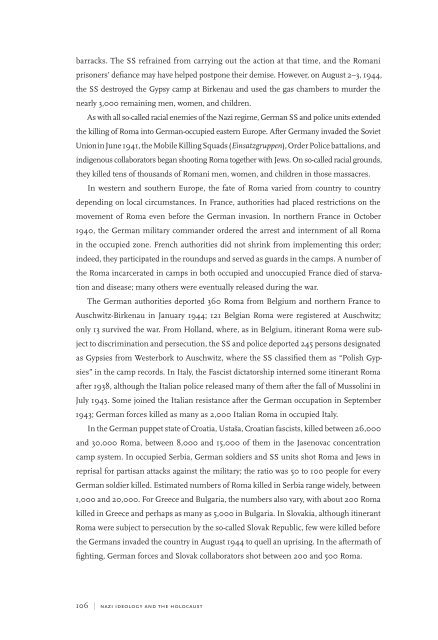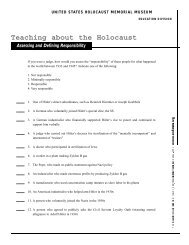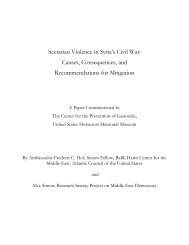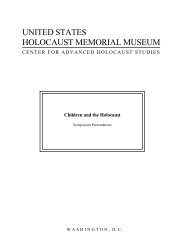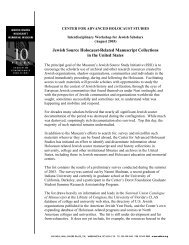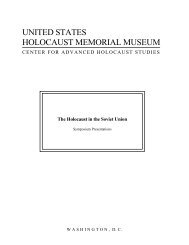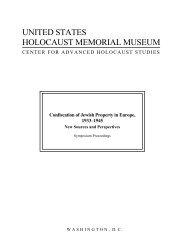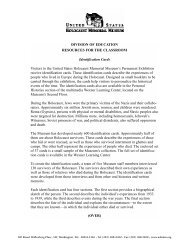the quest for racial purity - United States Holocaust Memorial Museum
the quest for racial purity - United States Holocaust Memorial Museum
the quest for racial purity - United States Holocaust Memorial Museum
Create successful ePaper yourself
Turn your PDF publications into a flip-book with our unique Google optimized e-Paper software.
arracks. The SS refrained from carrying out <strong>the</strong> action at that time, and <strong>the</strong> Romani<br />
prisoners’ defiance may have helped postpone <strong>the</strong>ir demise. However, on August 2–3, 1944,<br />
<strong>the</strong> SS destroyed <strong>the</strong> Gypsy camp at Birkenau and used <strong>the</strong> gas chambers to murder <strong>the</strong><br />
nearly 3,000 remaining men, women, and children.<br />
As with all so-called <strong>racial</strong> enemies of <strong>the</strong> Nazi regime, German SS and police units extended<br />
<strong>the</strong> killing of Roma into German-occupied eastern Europe. After Germany invaded <strong>the</strong> Soviet<br />
Union in June 1941, <strong>the</strong> Mobile Killing Squads (Einsatzgruppen), Order Police battalions, and<br />
indigenous collaborators began shooting Roma toge<strong>the</strong>r with Jews. On so-called <strong>racial</strong> grounds,<br />
<strong>the</strong>y killed tens of thousands of Romani men, women, and children in those massacres.<br />
In western and sou<strong>the</strong>rn Europe, <strong>the</strong> fate of Roma varied from country to country<br />
depending on local circumstances. In France, authorities had placed restrictions on <strong>the</strong><br />
movement of Roma even be<strong>for</strong>e <strong>the</strong> German invasion. In nor<strong>the</strong>rn France in October<br />
1940, <strong>the</strong> German military commander ordered <strong>the</strong> arrest and internment of all Roma<br />
in <strong>the</strong> occupied zone. French authorities did not shrink from implementing this order;<br />
indeed, <strong>the</strong>y participated in <strong>the</strong> roundups and served as guards in <strong>the</strong> camps. A number of<br />
<strong>the</strong> Roma incarcerated in camps in both occupied and unoccupied France died of starvation<br />
and disease; many o<strong>the</strong>rs were eventually released during <strong>the</strong> war.<br />
The German authorities deported 360 Roma from Belgium and nor<strong>the</strong>rn France to<br />
Auschwitz-Birkenau in January 1944; 121 Belgian Roma were registered at Auschwitz;<br />
only 13 survived <strong>the</strong> war. From Holland, where, as in Belgium, itinerant Roma were subject<br />
to discrimination and persecution, <strong>the</strong> SS and police deported 245 persons designated<br />
as Gypsies from Westerbork to Auschwitz, where <strong>the</strong> SS classified <strong>the</strong>m as “Polish Gypsies”<br />
in <strong>the</strong> camp records. In Italy, <strong>the</strong> Fascist dictatorship interned some itinerant Roma<br />
after 1938, although <strong>the</strong> Italian police released many of <strong>the</strong>m after <strong>the</strong> fall of Mussolini in<br />
July 1943. Some joined <strong>the</strong> Italian resistance after <strong>the</strong> German occupation in September<br />
1943; German <strong>for</strong>ces killed as many as 2,000 Italian Roma in occupied Italy.<br />
In <strong>the</strong> German puppet state of Croatia, Ustas˘ a, Croatian fascists, killed between 26,000<br />
and 30,000 Roma, between 8,000 and 15,000 of <strong>the</strong>m in <strong>the</strong> Jasenovac concentration<br />
camp system. In occupied Serbia, German soldiers and SS units shot Roma and Jews in<br />
reprisal <strong>for</strong> partisan attacks against <strong>the</strong> military; <strong>the</strong> ratio was 50 to 100 people <strong>for</strong> every<br />
German soldier killed. Estimated numbers of Roma killed in Serbia range widely, between<br />
1,000 and 20,000. For Greece and Bulgaria, <strong>the</strong> numbers also vary, with about 200 Roma<br />
killed in Greece and perhaps as many as 5,000 in Bulgaria. In Slovakia, although itinerant<br />
Roma were subject to persecution by <strong>the</strong> so-called Slovak Republic, few were killed be<strong>for</strong>e<br />
<strong>the</strong> Germans invaded <strong>the</strong> country in August 1944 to quell an uprising. In <strong>the</strong> aftermath of<br />
fighting, German <strong>for</strong>ces and Slovak collaborators shot between 200 and 500 Roma.<br />
106 | nazi ideology and <strong>the</strong> holocaust


